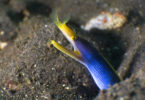Last Updated on February 10, 2023 by Matt
The Leather Bass, Dermatolepis dermatolepis, is a mid-sized grouper found in the Eastern Pacific Ocean. It is a ray-finned fish and a member of the family Serranidae alongside the sea basses and anthias. However the Leather Bass is part of the subfamily Epinephelinae which contains all groupers. Interestingly the genus and species name are the same!
In this quick article on the Leather Bass, we will give a physical description, give its distribution, and discuss its behavior.
IN THIS ARTICLE
Description
The Leather Bass has a deep body that is very laterally compressed; its depth is about the same as its standard length, the length from its snout to the beginning of the caudal fin. It is deepest at the origin of the dorsal fin. The forehead is very steep, and the eye is fairly small, being less than the diameter of the snout.
Leather Bass have one dorsal fin. The anterior dorsal fin is flat, and the posterior dorsal fin is rounded. The caudal fin is also rounded, while the pectoral fins are fairly short.
Adults and juveniles have distinctly different colorations and shapes. While adults have very deep bodies, juveniles are much less so. Adults have a dark greyish-brown coloration with alternating dark and lighter stripes. The dark stripes are dark grey to black and the light stripes are white to pale grey. The alternating bars are mottled and have many light white to pale blotches. All the fins except the anterior dorsal fin have a band of bright yellow on the margin.
Juveniles are black with white stripes which also extend onto the dorsal fin and anal fins. The anterior of the dorsal fin continues the stripes, while the posterior of the dorsal fin is white with black spots.
The Leather Bass is a mid-sized grouper; adults can reach a total length of 1 meter, and weigh as much as 125 kg (276 lb).
Distribution
The Leather Bass can be found on coral and rocky reefs along the western coast of North and South America in the Eastern Pacific Ocean.
Members of this species have been found from Southern California to Peru. Dermatolepis dermatolepis can also be found on the islands off this coastline, such as Clipperton Island, Cocos Island, and the Galapagos Islands.
Dermatolepis dermatolepis is found in greatest numbers in the Revillagigedo Islands.
They have been seen down to a depth of 50 meters, but their range is likely to extend to much greater depths.
Behavior
Leather Bass are diurnal predators, active during the day catching small benthic fish to eat. While they predominantly catch fish, they also feed on crustaceans such as crabs.
They are often seen following moray eels, catching fish which are disturbed by the eel as it moves and hunts in the crevices of the reef. It isn’t only moray eels that Leather Bass follow in this way. They are seen following and hiding amongst many different herbivorous fish, and they pick off small fish which are disturbed as the herbivorous fish graze.
Leather Bass often form schools, and also form spawning aggregations. During spawning groups of 30-70 individuals form, where the females release their eggs into the water column to be fertilized by the males.
Spawning aggregations have been recorded in the main to be formed from November to February.
Juvenile Leather Bass are most at risk from predation and will use the long spines of Centrostephanus and Diadema sea urchins for protection, hiding amongst the spines.
In Aquariums
Leather Bass isn’t suitable for the home aquarium. Juvenile Dermatolepis dermatolepis can be kept in an aquarium, but they grow quickly and will soon outgrow the tank they are being kept in.
They can be seen in certain professional public aquariums, but unfortunately aren’t available for home tanks.
Feature Image Credit: By keesgroenendijk – https://www.inaturalist.org/observations/19565923, CC BY-SA 4.0, https://commons.wikimedia.org/w/index.php?curid=91383813







